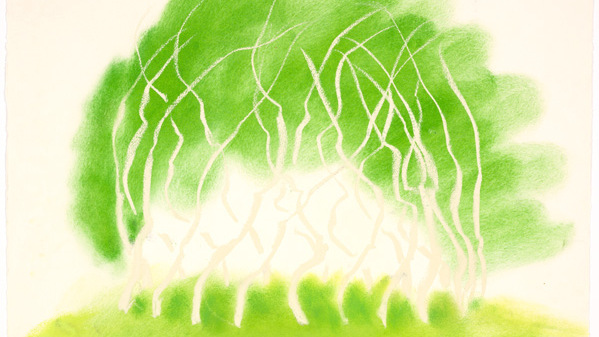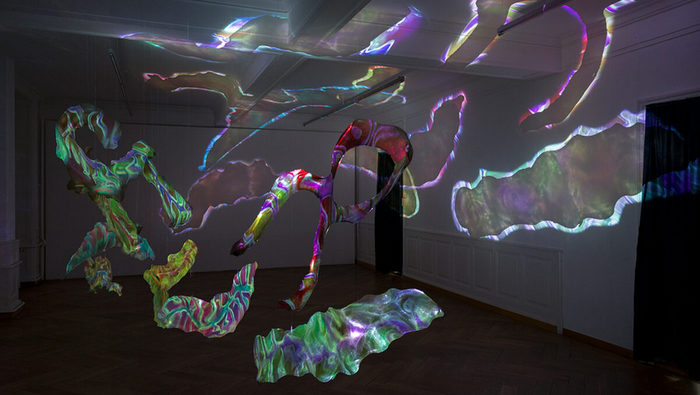White Cube Mason’s Yard is pleased to present the debut UK solo exhibition of the Japanese artist Yoko Matsumoto. Featuring paintings and works on paper from the mid-1980s to the present day, the exhibition introduces Matsumoto’s expressive and disciplined abstraction. Throughout her extensive body of work, colour exists as a unifying force that marries tempestuous energies with a mercurial sense of physicality. With a rigorous use of light, shade and hue, Matsumoto addresses colour in a processual and meditative manner, distinguishing material constitution, tonal mutability and layered dimensionality.
With the understanding that ‘colour determined form, and form obeyed colour’, Matsumoto has developed a practice that recognises the agency of colour as both conveyor and collaborator. Through immersive compositions, hues are layered in elaborate complexes across which the eye traces nebulous forms and fluid gestures. The vaporous, feathery and climatological turbulence of her compositions are executed with the intentionality of movement across the canvas, the body assuming primacy of painterly expression. Informed by lineages of Japanese art, in particular the monochromatic ink drawing practice of suiboku-ga, Matsumoto affiliates the transparency inherent to suiboku-ga with the gradated delicacy of traditional landscape painting. ‘My ideal was to express a space with transparency like an original ink painting’, the artist says, ‘fuzzy and indistinct things. An ideal space.’
Characterised by a reduced palette and chiaroscuro, Matsumoto’s paintings weave tapestries of light and shadow through intense and vivid pigment. In the ground floor gallery, seven early works dating from 1989 to the late 1990s showcase her pursuit of focused colour study through the modulation and variability of acrylic paint. Tracing the influence of Abstract Expressionism, particularly the work of Morris Louis and Helen Frankenthaler, which the artist first encountered in 1967 during a stay in New York, these works accumulate subtle variabilities of tone. Discovering new materials in America unavailable in Japan, namely acrylic paint (Liquitex) and raw cotton canvas, in this early work Matsumoto adopted a similar technique to Louis using thinned acrylics on gessoed canvas applied with a brush and then wiped with a cloth to gradually accrue sweeping nuances of colour.
Without prior calculation or preparatory drawing, Matsumoto’s work is intuited in free-form by physical movement and the body’s approximation of the canvas. The artist’s experimentation with different pressures of the hand and variable densities of pigment during the 1970s led to a wide variety of contours and tonalities within her painting. This is most visible in the now signature ‘pink’ works – or her genre of ‘hazy painting’ – which the artist began in 1970 and continued to develop for three decades. Eschewing the normative connotations of pink – as feminine or fantastical – Matsumoto privileges the spectrum of this shade as a mediator of entropic energy. ‘Unlike black and white, pink bears no concept; instead it exists, unreachable, in the innermost depths of our subconscious’, she says. ‘White and black promote my inner dialogues, and pink is the hue that lies beneath inexpressible thought.’
Born in 1936 in Tokyo, Matsumoto continues to live in the city of her birth, producing her labour-intensive pink canvases during periods of deep concentration. The physicality required to create her large-scale works sees process become embedded within the material itself, expressing a continuity between painter and painting: ‘Since I paint with the work lying on the floor, my sweat is constantly dripping on it. It’s manual labour, pure and simple, with no time to question. The work doesn’t allow me to think, and with no time to think I become one with the painting.’ It is in this way that Matsumoto’s work realises a spatiotemporal realm of painting where self, material and colour coexist.
A series of delicate charcoal and pastel drawings presented in the lower ground floor depict expressive, tactile mark-making rendered on an intimate scale. Dense and brooding in atmosphere, their imagery recalls the blustery contours of a windswept landscape or the cavernous, inscrutable depth of interiority. This painterly language runs through Matsumoto’s oil paintings, a medium to which she returned in the early 2000s. Begun in the summer of 2004, the ‘green’ paintings consider the affective vitalities of nature as well as its historic representation, from Cézanne’s The Great Pine (1889) to Monet’s series of haystacks or Hishida Shunsō’s epic Fallen Leaves (1909).
In the lower ground floor gallery, a selection of paintings produced from 2006 onwards – several of which were made in the past five years – explore how far the medium can be taken solely on the potency of the colour green. These works depict a complex pictorial space within their viridian clouds, summoning a haze of lush tones underwritten by streaks of Mediterranean blue. Cascades of emerald are relieved by dashes of vermilion and layers of charcoal black or hoary white deepen and illuminate the planar surface. For Matsumoto, the use of blue, though seemingly discreet, embodies a ‘magical force’ that ‘transcends all boundaries’ and is capable of transforming the space and qualities of a painting. The artist says of these works: ‘I think I was able to depict a space that seems to approach the viewer. Many people think of space as simply an expanse. However, there is a kind of space that comes at the viewer from the other side, from the painting. Space also has a variety of complex movements.’ The inclement, cyclonic or riparian states these paintings appear to summon is rather a sensing of space that is beyond defined location: ‘a nature beyond our senses, a vision of the human soul or of living essence [...] transformed into an awareness of the natural world we can see and touch.’
In more recent paintings, Matsumoto concentrates on tones of white applied with a roller. Controlling the space and pressure of the roller’s drag results in a variable torrent of pigment, creating dense striations of white that blur and diffuse as though iridised, delivering a mystified space that both obscures and envelops. Evolving from studies of the sky, these bleary abstractions evoke the spiritual, qualities that the artist likens to an ‘afterlife’. ‘I have a desire to express something that is not clear’, Matsumoto acknowledges. With embodied knowledge of her medium, Matsumoto works within the sobering space of painting itself to both mine and liberate the capricious essences of colour and light.
This exhibition is organised in collaboration with Hino Gallery.
18 January – 9 March 2024
White Cube Mason’s Yard
25 – 26 Mason's Yard
London SW1Y 6BU
Source: White Cube
Related Publications

Galerie Lelong & Co. | David Nash
November 22, 2024(S)elf Portraits: Fiction, Fantasy, and Sci-Fi in Portrait
November 18, 2024
Auswahl 24- Guest artist: Victoria Holdt
November 15, 2024










